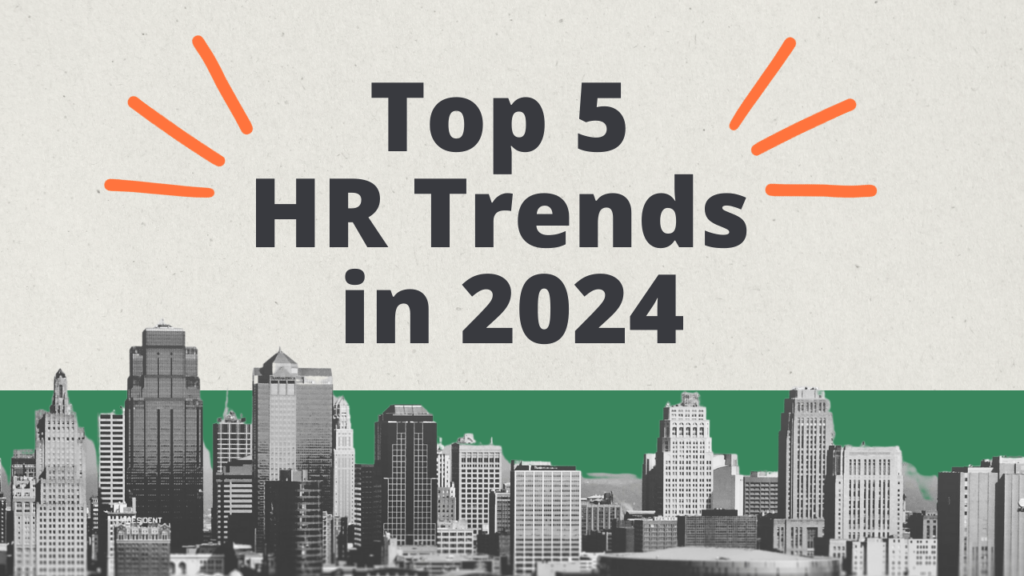Top 5 HR Trends in 2024

Table of Contents
Human resources is a field currently undergoing major changes. As technological advancements, managerial approaches, organizational philosophies, changing workforce dynamics, and other emerging trends and ideas occur, HR professionals must be prepared to consistently adapt and continuously look ahead to the future.
As 2023 comes to a close, and we enter 2024, now is the time for organizations to begin thinking forward to developing trends and how their HR divisions should address them.
By proactively establishing strategies, organizations can stay ahead of the curve, experience easier transitions, and keep up a competitive advantage.
So, as 2024 arrives, what’s next?
In a recent survey, Gartner found leader and manager development topped the list of HR trends to watch in the upcoming year.
Other noteworthy trends include organizational culture, HR technology, and career management/internal mobility.
The ongoing debate of remote vs. back-to-office workplace models will also continue to remain at the forefront.
Let’s take a look at these five top trends you can anticipate in 2024.
1. Establishing a commitment to leader and management development

Leaders and managers play critical roles in an organization. Over the decades, newer leadership styles emerged, contrasting with traditional styles, prompting leaders to reconsider how their style fits into their organizations.
Current and future leaders will continue to need to be prepared to effectively evolve with the times, especially since modern organizations face unprecedented challenges.
In years past, a leader or manager’s job had a primary focus on operational success. While this is still important, the definition of what constitutes organizational success has changed.
Success in leadership is no longer strictly tied to key metrics, such as profitability and growth. Today, managerial decision-makers also need to give attention to nurturing sustainable and agile organizations.
In 2024, like everyone else, leaders will need upskilling.
They’ll need to bring themselves up to speed with technology, learn how to leverage data, and identify better ways to set and track goals.
When it comes to managing employees, anticipated trends will lean toward improving coaching skills, giving better employee reviews and assessments, offering team feedback opportunities, and overall emphasizing their willingness to be a source of support to the people they lead.
2. Fostering a better organizational culture

An emphasis on fostering a better organizational culture is another trend anticipated to continue in 2024. Over the past three years, organizations have experienced a massive cultural shift.
This includes revamping hiring processes to build better talent pipelines, eliminating unconscious bias, and building inclusive leadership skills, to name a few primary factors significantly impacting an organization’s culture.
Historically, nurturing strong organizational cultures leads to stronger productivity, higher morale levels, and an overall positive environment.
Today, additional factors affecting the betterment of organizational cultures in other ways join them at the forefront.
These include:
- Promoting diversity, equity, and inclusion (DEI) mindsets
- Focusing on employees’ physical and mental wellbeing
- Developing effective change management strategies
- Creating transparency
- Establishing trust between leaders and employees.
Many HR departments will also create mental health programs, teach stress management strategies, offer diversity training, and develop schedules to promote balanced lifestyles.
The end goal will be to build a corporate culture where employees feel valued, empowered, respected, and appreciated.
To accomplish the development of this type of environment, many HR professionals will play a more active role in nurturing and encouraging wellness, acceptance, diversity, and inclusiveness.
3. Embracing HR technology

Technology continues to be a major disruptor across all fields. HR is no exception.
Professionals will need to stay on top of emerging and maturing technologies to remain competitive. Some technologies HR professionals should pay attention to include:
Artificial intelligence
AI, including chatbots and other automated tools, are becoming mainstream. AI will play a role in recruiting, screening, and onboarding processes, along with improving employee engagement, and measuring employee performance.
AI tools will help streamline HR administrative duties, enhance data analytics, and eliminate many repetitive tasks, allowing HR staff members to focus on other core areas while enhancing their abilities to identify skills gaps and find talent to fill those roles.
However, AI comes with its own set of issues such as privacy and bias. We need to ensure there are privacy safeguards for employees and minimize potential bias in how algorithms evaluate candidates and employees.
Advanced analytics tools
These tools can help streamline HR processes, create better decision-making opportunities, gain insights into employee engagement levels and performance, and improve employee experiences.
Predictive analytics
Predictive analytics can be used to boost abilities in talent acquisition, build robust talent pipelines, and develop better workforce planning.
Algorithmic management
Algorithmic management can prove valuable in helping to identify data and patterns to help improve HR decision-making across the spectrum of an HR department’s responsibilities.
Other technologies
Other technologies that can be integrated into HR are just beyond the horizon may include the metaverse and virtual reality. These can be utilized in conjunction with recruiting, training, and team-building processes. Furthermore, technology can be used to find the “hidden workforce” to help quickly fill vacancies and round out teams.
The majority of emerging technologies will be linked to some form of AI, but do have differing factors. To facilitate the efficiency of their departments, HR professionals will need to embrace new tech tools and learn how to leverage them to streamline their processes.
4. Offering career management and internal mobility opportunities

Decades ago people would start their first job and chances were good they’d spend their career at one company.
That trend is long gone. As a result, organizations are often paying dearly as they absorb the costs associated with high turnover.
To retain top talent, an investment in career management strategies and finding ways to provide opportunities for internal mobility can prove worthwhile.
Being skills-based hiring was on the rise in 2023, offering ways to promote internal mobility is probably a smart strategy.
If employees are not qualified to apply for vacant positions and the company continuously invests in external recruiting, it’s highly probable employees will eventually seek greener pastures.
As 2024 arrives, organizations are realizing the value of investing in employee career development rather than spending all resources and energies on external recruitment.
Giving team members the ability to upskill themselves may give them a reason to stay. Organizations are likely to:
- Provide in-house and external training sessions
- Create continuing education partnerships
- Offer discounted courses and certifications
- Seek other upskilling and reskilling learning opportunities
Important to note, that some of the top attributes Millennials and Gen Z’ers are seeking in job prospects include opportunities to learn and grow, advancement opportunities, and interesting/meaningful work.
We recommend that managers also invest time and effort into soft-skill training. For example, a session about active listening can lead to better team cohesion.
Not only do career management opportunities provide a means for employees to gain new skills and learn new and interesting things, but it’ll also empower them to adapt to other industry changes, challenges, and emerging disrupters in their current roles, providing them an opportunity to stay relevant and happy in their jobs.
5. Establishing new work structures

In 2020 during the COVID-19 pandemic work structures took a dramatic shift to support remote and hybrid models. However, in 2023, we saw a huge push for a back-to-office structure.
The problem with this is many employees found themselves preferring flexible remote and hybrid options.
In fact, one study suggests that 73% of full-time employees who prefer hybrid work schedules and 78% of those wanting remote work schedules would “sacrifice to do it.”
This translates to even quitting their jobs to work elsewhere or swapping industries to get what they want.
Overall, the study found a whopping 89% of American workers prefer remote work, hybrid work, or 4-day workweeks.
If this study is any indicator, it is a clear signal that organizations will need to reconsider their push for back-to-the-office work schedules without offering some compromises.
In 2024, HR professionals will need to balance the challenge of meeting both employer and employee desires for the type of work structures their organizations will support.
Solutions may include flexible schedules to accommodate both employer and employee preferences, and bringing virtual “vibes” to the office with flexible workspaces or other accommodations.
Overcoming some of these challenges can also include developing and managing a combination of different teamwork models (remote, hybrid, in-house).
The tricky part will be finding ways to foster team collaboration, keep productivity strong, and maintain employee engagement.
It is likely this will circle back to technology trends to identify better communication and collaboration tools.
Bottom line, phygital isn’t just used for marketing anymore. For HR, it’s also likely going to be the new normal going forward whether people work in or out of the office.
Organizational decision-makers will need to keep this in mind as they make their choices when it comes to how they’ll allow work locations and schedules to be structured. Blended work models are probably here to stay.
Investing in HR trends may help maintain a good balance
HR professionals likely will face many challenges throughout 2024 as new trends make their way into workplaces.
As they work to better their organizations and maintain a competitive advantage, the potential for HR employee burnout increases.
However, embracing some of the new trends and tools that accompany them could make their jobs easier in 2024 and beyond.
Either way, next year is likely going to be a transformative one for human resources and will likely bring about some bumpiness along the journey.
By embracing innovative ideas, tools, and strategies to stay ahead of the curve, the result can be a win-win for everyone across an organization.
